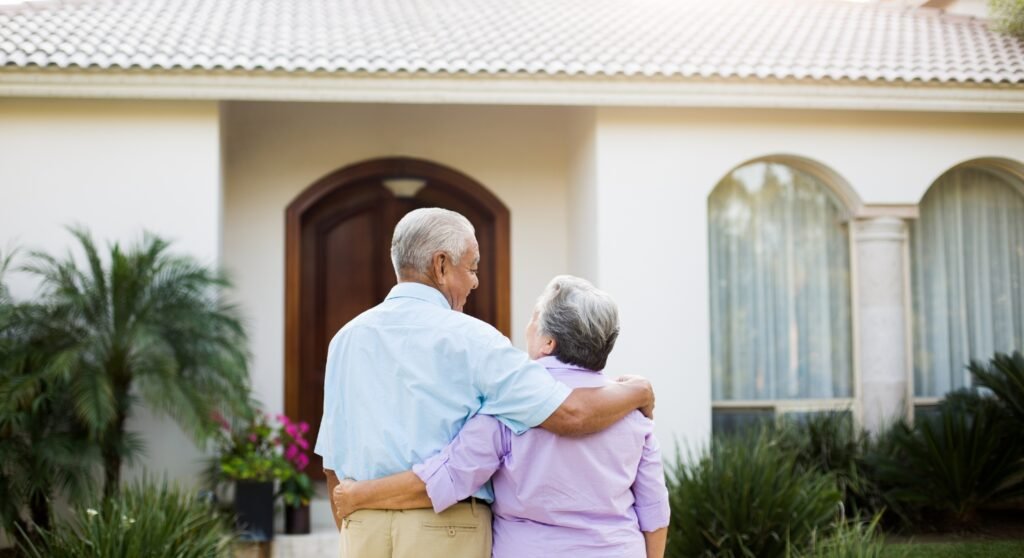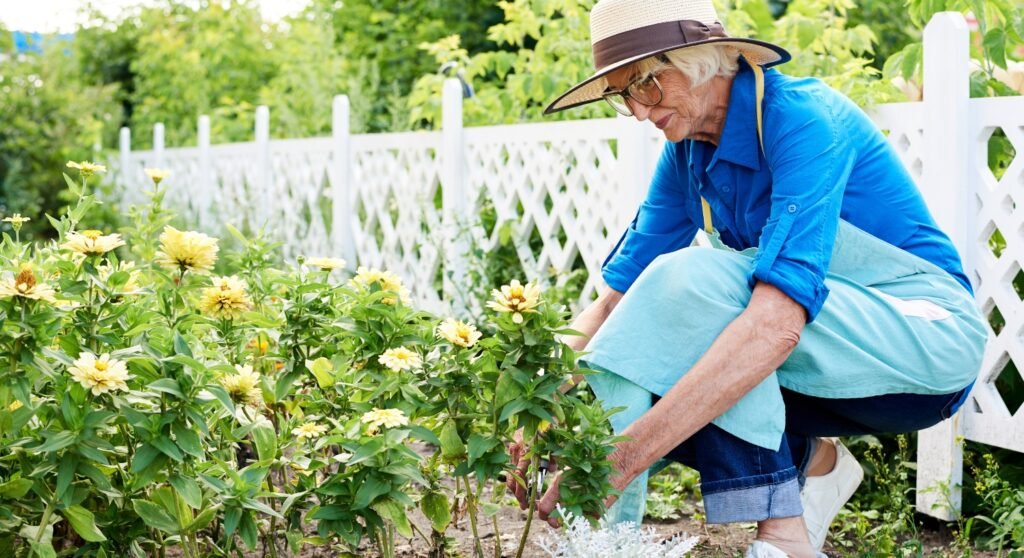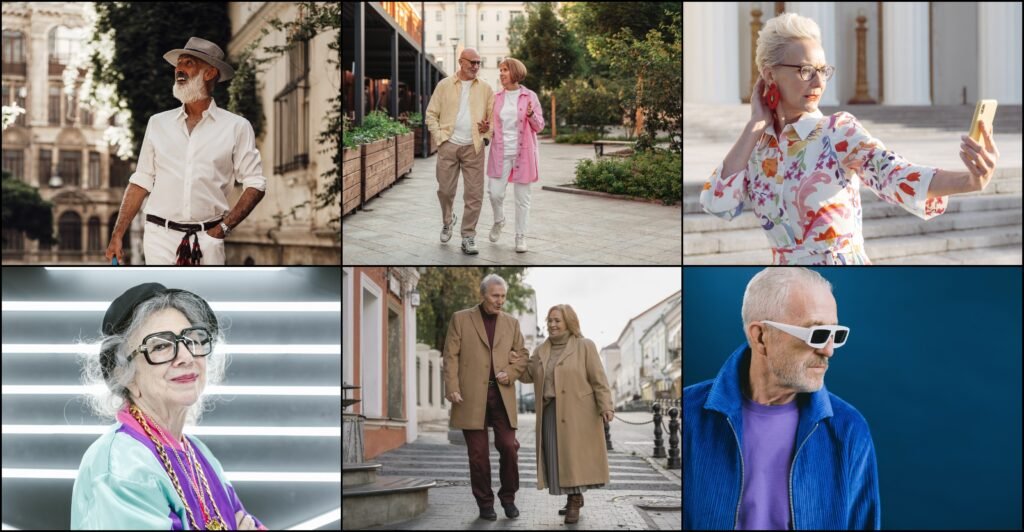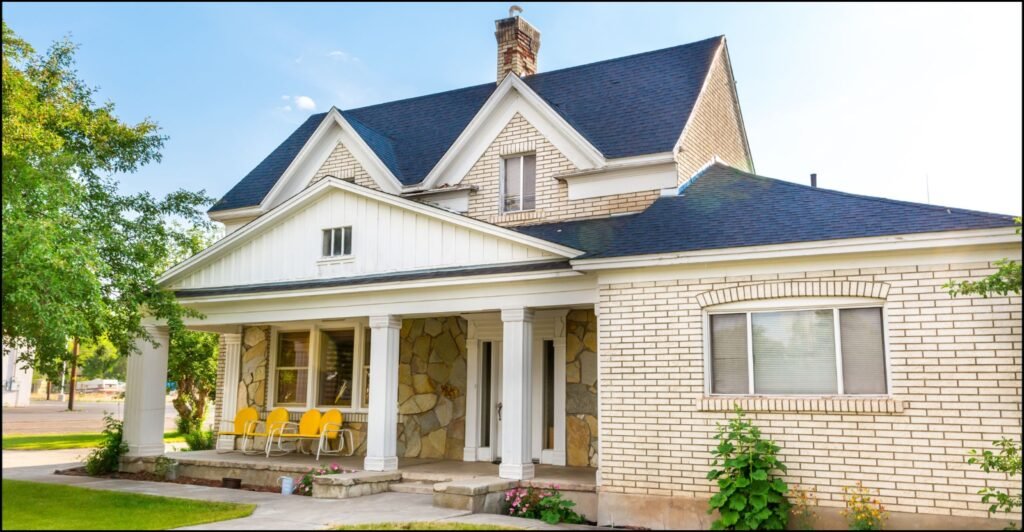Creating Your Outdoor Sanctuary: The Ultimate Guide to Seating and Shade for Seniors
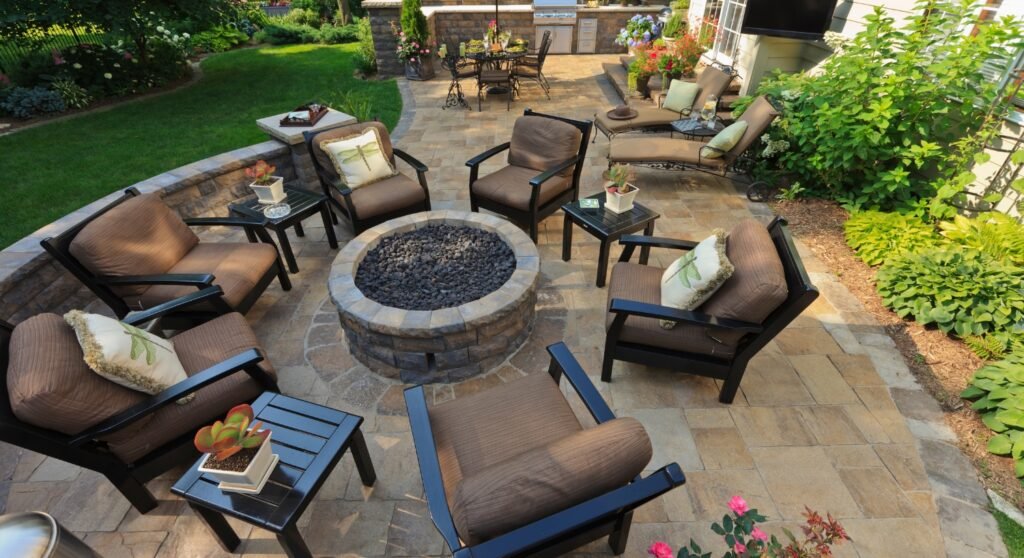
Last Updated on June 30, 2025 by Julian Espinosa
Have you been dreaming of a serene outdoor retreat where you can relax in perfect comfort? Creating an inviting garden space with optimal seating and shade isn’t just about aesthetics—it’s about crafting an environment that nurtures well-being, promotes safety, and enhances quality of life for seniors. Whether you’re redesigning your own garden oasis or helping a loved one create their perfect outdoor haven, this comprehensive guide offers everything you need to transform any outdoor space into a comfortable sanctuary.
The right combination of seating and shade can make all the difference between an occasionally used garden and a beloved daily retreat. From understanding the unique needs of seniors in outdoor spaces to selecting materials that offer both comfort and durability, we’ll explore practical solutions that blend function with beauty. We’ll cover everything from health benefits and shade options to accessibility considerations and personal touches that make a garden feel like home.
Ready to discover how thoughtful design choices can create an outdoor space that supports physical well-being, encourages social connection, and provides a peaceful retreat? Let’s explore the essential elements of creating the perfect seating and shade for seniors, with expert tips and recommendations to guide you every step of the way.
Understanding the Needs of Seniors in Gardens
Creating a garden space that truly serves seniors requires thoughtful consideration of their unique needs and preferences. This isn’t simply about placing a bench under a tree—it’s about understanding how outdoor environments can be optimized for comfort, safety, and enjoyment at every stage of the aging journey.

The Importance of Inclusive Design
When designing outdoor spaces for seniors, accessibility should be seamlessly integrated with beauty. Gardens should invite exploration while minimizing physical barriers. This means considering factors such as:
- Stable, level walking surfaces that reduce trip hazards
- Comfortable seating options that support proper posture
- Strategic shade placement that protects from harmful UV rays
- Clear sightlines and adequate lighting for safety
- Ergonomic considerations for ease of movement
For many seniors, the garden represents freedom, connection with nature, and a space for both solitude and socialization. A well-designed outdoor environment acknowledges that mobility levels may change over time, but the desire to enjoy outdoor living remains constant.
Adapting to Changing Needs
Just as our indoor living spaces often need modifications to accommodate changing physical abilities, outdoor spaces benefit from the same thoughtful approach. The perfect garden for seniors anticipates potential challenges while creating an environment that feels natural and inviting rather than clinical or institutional.
Prefer to listen rather than read?

Health Benefits of Seating and Shade for Seniors in Their Gardens
The importance of properly designed outdoor spaces for seniors extends far beyond simple comfort—these environments play a crucial role in supporting overall health and well-being.
Physical Health Benefits
As we age, our skin becomes more vulnerable to sun damage, making protection from harmful UV rays increasingly important. Research from the American Academy of Dermatology indicates that seniors are at higher risk for skin cancer and sun-related skin damage, with studies showing that proper shade can reduce UV exposure by up to 75% (American Academy of Dermatology, 2023).
Beyond sun protection, comfortable seating supports proper posture and joint health. According to a 2023 study in the Journal of Environmental Psychology, ergonomically designed outdoor seating can reduce discomfort for individuals with arthritis and other joint conditions by up to 40% compared to standard seating options.
Mental and Social Health Benefits
The benefits of spending time outdoors extend well beyond physical health. Recent research published in the International Journal of Environmental Research and Public Health (2024) found that seniors who spent at least 30 minutes daily in green spaces showed significant improvements in:
- Reduced stress levels (measured by lower cortisol levels)
- Improved mood and decreased symptoms of depression
- Enhanced cognitive function
- Better sleep quality
- Increased social interaction
Well-designed seating areas that encourage conversation and togetherness help combat isolation and loneliness—factors increasingly recognized as serious health risks for seniors. Circular or face-to-face seating arrangements have been shown to increase social interaction by up to 50% compared to linear seating options.
Temperature Regulation Benefits
Proper shade isn’t just about sun protection—it plays a vital role in temperature regulation. A 2024 study in the Journal of Biometeorology found that seniors are significantly more vulnerable to heat-related illness, with heat stroke risk increasing by 4% each decade after age 60. Strategic shade placement can reduce ambient temperatures by 10-15°F, helping prevent dangerous overheating during warmer months.
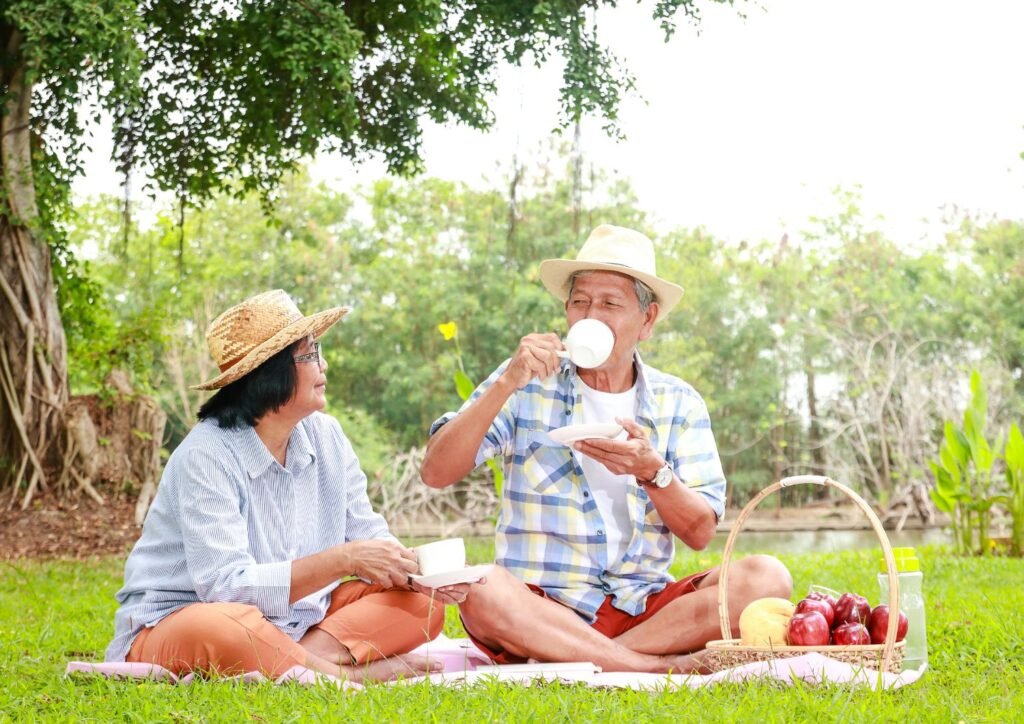
Types of Shade Solutions
Creating the ideal outdoor environment for seniors requires thoughtful consideration of different shade options. Each solution offers unique benefits that can be tailored to specific needs, preferences, and garden layouts.
Natural Foliage: Living Shade with Beauty
Natural foliage stands out as a remarkable option, providing not just practical shade but also creating a serene and aesthetically pleasing environment. Incorporating trees and shrubs into a senior-friendly garden brings multiple benefits:
- Natural cooling effect
- Trees don’t just block sunlight—they actively cool the surrounding air through transpiration. According to the U.S. Forest Service, this can reduce ambient temperatures by 2-9°F compared to unshaded areas.
- Improved air quality
- Plants naturally filter pollutants, which is particularly beneficial for seniors with respiratory conditions.
- Psychological benefits
- Research shows that being surrounded by natural elements reduces stress hormones and promotes feelings of well-being.
- Seasonal variation
- Deciduous trees provide shade during hot summer months while allowing warming sunlight during winter.
Important safety consideration: While natural foliage provides excellent shade, regular maintenance is essential. Falling branches or overgrown roots can create hazards for seniors with mobility challenges. Implement a regular pruning schedule and consider consulting with an arborist annually to ensure all trees and large shrubs remain safe.
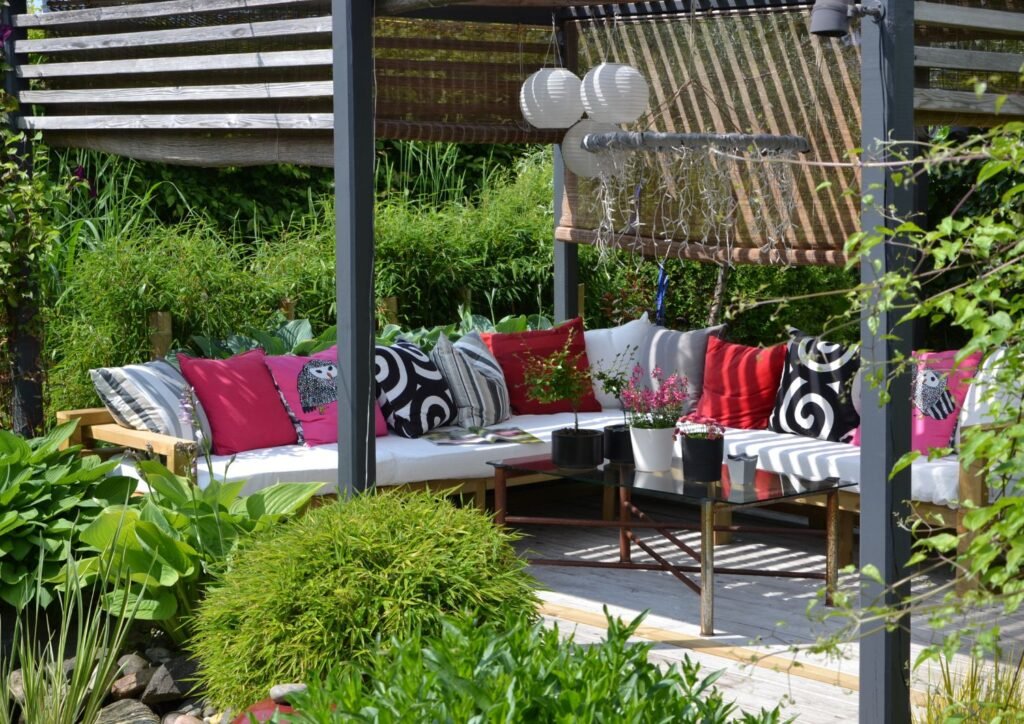
Choosing the Right Trees and Plants for Shade
When selecting trees and plants for a senior-friendly garden, consider both functionality and maintenance requirements:
Best Trees for Shade
- Medium-sized deciduous trees
- Maple, birch, and flowering dogwood provide excellent shade without overwhelming smaller spaces.
- Dwarf varieties
- For smaller gardens, consider dwarf fruit trees that provide both shade and enjoyment.
- Growth rate consideration
- Fast-growing trees like poplar or willow provide quicker shade but typically have shorter lifespans and may require more maintenance.
Complementary Plants
Layering different plants creates more comprehensive shade:
- Understory shrubs: Hydrangeas, rhododendrons, and viburnums thrive in partial shade and add texture.
- Ground covers: Hostas, ferns, and pachysandra require minimal maintenance while helping to cool the ground temperature.
Architectural Structures: Reliable Year-Round Solutions
For more controlled and immediate shade solutions, architectural structures offer reliability regardless of season:
Pergolas and Gazebos
These classic structures provide defined outdoor “rooms” with adjustable shade levels:
- Pergolas can be fitted with retractable canopies or combined with climbing plants for natural coverage.
- Gazebos offer complete overhead protection while allowing for airflow from all sides.
Recent advances in pergola design include motorized options that can be easily adjusted with the push of a button—ideal for seniors who might struggle with manual adjustments.
Awnings and Shade Sails
Modern shade solutions offer flexibility and style:
- Retractable awnings can be extended or retracted based on weather conditions and sun position.
- Shade sails provide an architectural element while effectively blocking UV rays (most quality options block 95-98% of harmful rays).
When selecting architectural shade structures, prioritize options with:
- Weather-resistant materials
- Look for powder-coated aluminum frames and marine-grade fabrics.
- Wind ratings
- Ensure structures can withstand local weather conditions.
- Easy operation
- For adjustable options, consider motorized versions with remote controls.
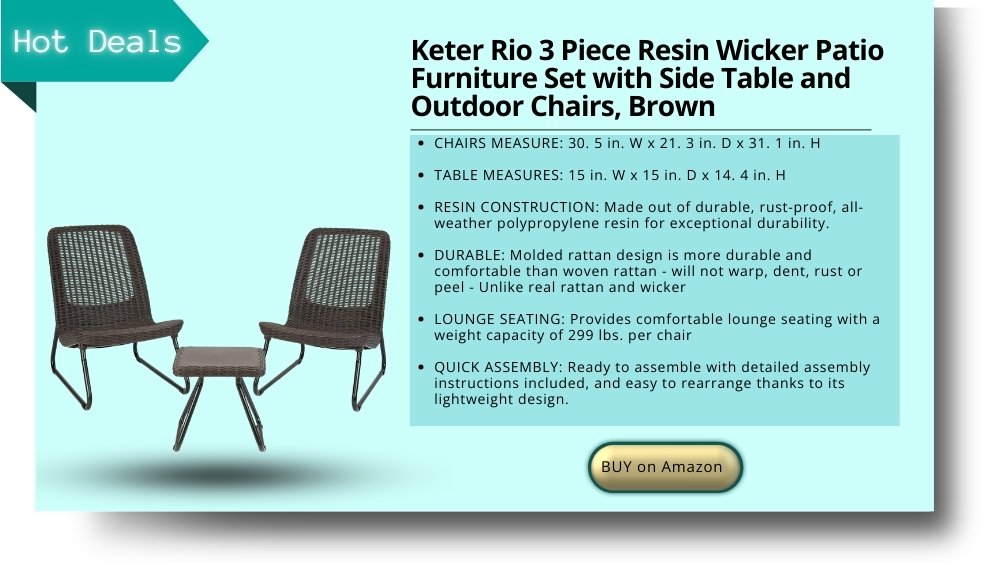
Seating and Shade: Picking the Best Materials
The materials used for outdoor seating and shade structures play a crucial role in creating comfortable, durable, and safe environments for seniors. The right choices can significantly enhance the usability and longevity of these outdoor elements.
Aluminum: Lightweight Yet Strong
Aluminum has become increasingly popular for outdoor furniture due to its practical benefits for seniors:
- Exceptionally lightweight
- Chairs weighing 5-8 pounds can be easily moved by most seniors.
- Weather-resistant properties
- Naturally resistant to rust and corrosion.
- Low maintenance requirements
- Generally requires only occasional wiping with mild soap and water.
- Temperature consideration
- Can heat up in direct sunlight, making cushions essential.
Polywood: Eco-Friendly Wood Alternative
This innovative material offers numerous advantages:
- Resembles traditional wood
- Provides the aesthetic appeal of wood without maintenance concerns.
- Made from recycled plastics
- Environmentally friendly option that prevents plastics from entering landfills.
- Exceptional durability
- Withstands harsh weather conditions without cracking, peeling, or rotting.
- Stays cooler than metal
- Doesn’t conduct heat as readily as aluminum, making it more comfortable in direct sun.
- Stability
- Heavier than aluminum (typically 15-25 pounds per chair), providing sturdy support but requiring more strength to move.
Teak and Other Hardwoods
For those preferring natural materials:
- Natural beauty
- Ages to a distinguished silver-gray patina if left untreated.
- Natural oils
- Contains natural oils that resist rot, insects, and weathering.
- Temperature neutral
- Doesn’t get excessively hot or cold with temperature changes.
- Weight consideration
- Typically heavier than synthetic options, which provides stability but may make repositioning challenging.
Optimal Cushion and Shade Fabrics
UV-Protective Fabrics
Modern outdoor fabrics have advanced significantly:
- Sunbrella® and similar performance fabrics: Block up to 98% of harmful UV rays while remaining breathable.
- Solution-dyed acrylics: Color runs throughout the fabric rather than just on the surface, preventing fading.
- Water-resistant properties: Repel light moisture while allowing air circulation to prevent mold and mildew.
- Cleanability: Most premium outdoor fabrics can be cleaned with mild soap and water or even diluted bleach for stubborn stains.
Cushion Considerations
For maximum comfort:
- Quick-dry foam: Specialized outdoor foam with antimicrobial properties allows water to flow through rather than absorb.
- Ergonomic design: Look for cushions with lumbar support and proper height to make sitting down and standing up easier.
- Attachment features: Straps or non-slip backing prevent cushions from sliding, reducing fall risks.
Material Selection Guidelines
When selecting materials for senior-friendly outdoor spaces, prioritize options that balance:
- Comfort: Materials that don’t become too hot or cold and provide proper support.
- Durability: Ability to withstand weather conditions with minimal maintenance.
- Weight and maneuverability: Consider who will be moving the furniture and how often.
- Aesthetics: Visual appeal that creates an inviting environment.
- Safety: Non-slip surfaces and rounded edges to prevent injuries.
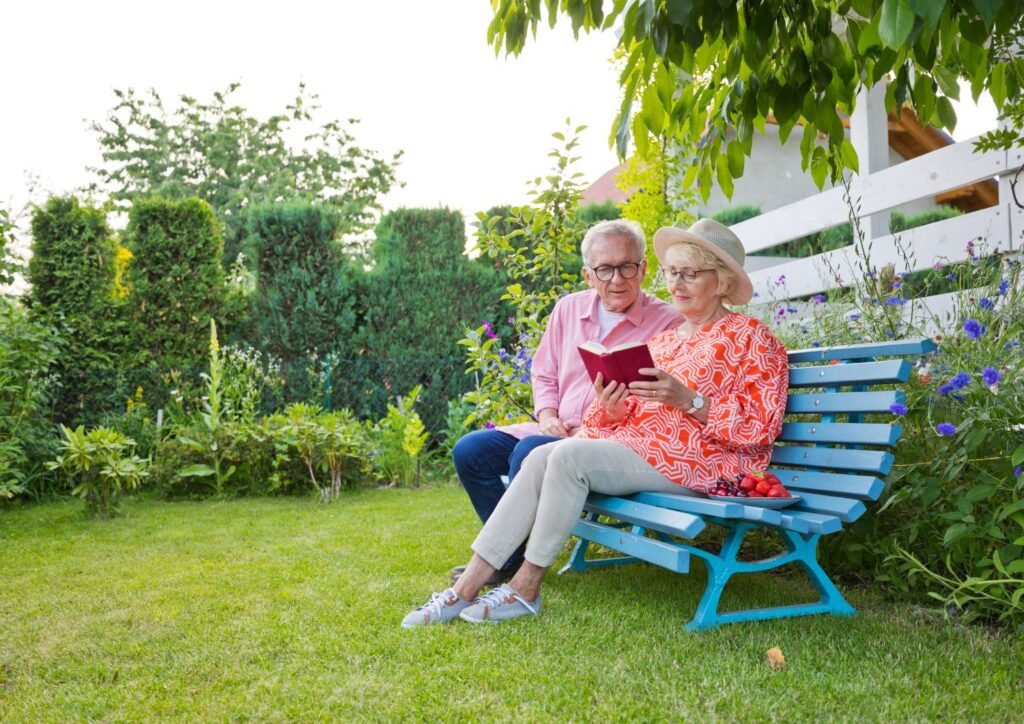
Providing Diverse and Comfortable Seating Options
Creating truly inclusive and welcoming garden spaces for seniors requires thoughtful attention to seating diversity and placement. The goal extends beyond simply providing places to sit—it’s about designing environments that support well-being, encourage social connection, and accommodate varying needs.
Variety of Seating Types
A well-designed garden should offer multiple seating options to accommodate different preferences and physical requirements:
Benches with Proper Support
- Ergonomic considerations
- Look for designs with seats 17-19 inches high and back supports at approximately 100-degree angles for optimal comfort.
- Armrests
- Essential for providing leverage when sitting down or standing up, reducing strain on the back and knees.
- Materials
- Consider using wood or polywood for temperature regulation, as metal benches can become uncomfortably hot or cold.
Supportive Individual Chairs
- Seat depth and width
- Ideally 16-18 inches deep and at least 18 inches wide to accommodate most body types comfortably.
- Stability
- Four-legged designs typically offer more stability than cantilevered options.
- Weight capacity
- Select chairs rated for at least 250-300 pounds to ensure safety for users of all sizes.
Conversation Areas
- Arrangement: Position seating in small groups to facilitate conversation—circular or semi-circular arrangements work best.
- Face-to-face options: Ensure some seating is arranged to allow people to face each other at comfortable distances (3-6 feet apart).
- Inclusive spacing: Leave space for mobility devices so wheelchair users can join seated groups comfortably.
Strategic Placement for Comfort and Safety
The positioning of seating is just as important as the seating itself:
Shade Considerations
- Time-based placement: Analyze sun patterns throughout the day and season to position seating where it will receive appropriate shade during peak usage times.
- Microclimate awareness: Place some seating in areas that receive morning sun but afternoon shade—particularly beneficial during cooler seasons.
- Temperature buffer zones: Create seating areas near water features or lush plantings that naturally cool the surrounding air.
Accessibility Factors
- Path proximity: Position seating adjacent to accessible pathways (ideally no more than 10 feet from main paths).
- Rest intervals: On larger properties, place seating at regular intervals (every 25-30 feet) along pathways to provide rest stops.
- Surface transitions: Ensure the ground around seating areas is level, stable, and blends smoothly with surrounding pathways.
Social Interaction Considerations
Thoughtfully designed seating can significantly impact social engagement:
- Flexible arrangements: Include some movable seating that can be reconfigured based on group size or activities.
- Privacy options: Create both communal seating areas and more private nooks for solitary enjoyment or intimate conversations.
- Activity adjacency: Position seating near features of interest (bird feeders, water features, or raised garden beds) to provide both comfort and entertainment.
According to recent research from the University of British Columbia (2023), seniors who have access to varied outdoor seating options spend approximately 38% more time outdoors and report 45% higher satisfaction with their living environment compared to those with limited seating options.
Lighting and Visibility
Creating safe and accessible outdoor environments for seniors requires careful attention to lighting and visibility. As we age, our visual acuity naturally decreases, making proper illumination essential for both safety and enjoyment of outdoor spaces.
The Importance of Adequate Lighting
Vision changes commonly associated with aging include:
- Reduced ability to distinguish contrast (typically declining by 33% by age 70)
- Increased sensitivity to glare
- Slower adjustment between light and dark areas
- Diminished depth perception
These natural changes make strategic lighting crucial for senior-friendly outdoor spaces. According to the American Foundation for the Blind, individuals over 60 typically need three times more light for comfortable reading and detailed tasks compared to individuals in their 20s.
Lighting Strategies for Safety and Comfort
Pathway Illumination
- Low-profile lighting: Position lights at 14-18 inches above ground to illuminate pathways without creating harsh glare.
- Consistent spacing: Place lights at regular intervals (typically every 8-10 feet) to eliminate dark zones between fixtures.
- Color temperature: Opt for warm white lighting (2700-3000K) which provides good visibility while creating a welcoming atmosphere.
Seating Area Lighting
- Layered approach: Combine ambient, task, and accent lighting to create well-illuminated yet comfortable seating areas.
- Adjustable options: Consider dimmable fixtures that can be adjusted based on time of day and activities.
- Indirect lighting: Utilize reflected light (such as wall-washing or up-lighting) to minimize harsh shadows and reduce glare.
Smart Lighting Solutions
Modern technology offers excellent options for senior-friendly garden lighting:
- Motion-activated systems: Automatically illuminate pathways when movement is detected.
- Dusk-to-dawn sensors: Maintain appropriate lighting levels regardless of seasonal daylight changes.
- Remote controls or smartphone apps: Allow easy adjustment without requiring outdoor trips after dark.
Energy-Efficient Options
Solar lighting has improved dramatically in recent years, offering practical benefits for senior-friendly gardens:
- Elimination of wiring: Reduces tripping hazards from cords and simplifies installation.
- Sustainability: Renewable energy source with minimal environmental impact.
- Cost-effectiveness: After initial investment, operating costs are negligible.
When selecting solar options, look for:
- Battery capacity: Higher-quality units store enough energy for 8-12 hours of illumination.
- Light output: Minimum 50-80 lumens for pathway lights and 150-300 lumens for area lighting.
- Weather resistance: IP65 rating or higher to ensure durability in all conditions.
Contrast and Visibility Enhancement
Beyond lighting, other design elements can improve visibility and navigation:
- Color contrast: Use contrasting colors to define edges, steps, and transitions (e.g., darker border around lighter pathway).
- Reflective elements: Incorporate reflective materials or edge markers that increase visibility at night.
- Visual cues: Use consistent design elements to signal transitions or decision points along pathways.
According to landscape design studies, implementing proper contrast in outdoor spaces can reduce fall incidents among seniors by up to 30% and significantly increase confidence in navigating outdoor environments after sunset.

Slip-Resistant Surfaces
Safety underfoot is a critical but often overlooked aspect of creating senior-friendly outdoor spaces. Falls represent one of the most serious health risks for seniors, with outdoor falls accounting for nearly 48% of all fall-related injuries among adults over 65, according to the Centers for Disease Control and Prevention (2023).
The Science of Slip Resistance
Surface slip resistance is measured using a coefficient of friction (COF)—the higher the number, the more slip-resistant the surface. For exterior applications where water exposure is likely:
- Minimum recommended COF: 0.42 for level surfaces
- Recommended COF for senior safety: 0.60 or higher, particularly for sloped areas
- ADA compliance minimum: 0.50 for accessible routes
Optimal Flooring Materials for Seating Areas
Natural Stone Options
- Textured granite: Provides excellent slip resistance (typical COF of 0.65-0.75) and exceptional durability.
- Flagstone: Naturally textured surface offers good traction (COF typically 0.55-0.70) while blending beautifully with garden environments.
- Slate: Available in textured finishes that provide excellent slip resistance (COF of 0.60-0.80) but should be sealed to prevent flaking.
Manufactured Materials
- Stamped concrete: Can be finished with anti-slip additives to achieve COF ratings of 0.65-0.85.
- Composite decking: Modern options feature enhanced grip surfaces with COF ratings of 0.50-0.70 even when wet.
- Interlocking pavers: Available with textured finishes and can incorporate drainage features to prevent water accumulation.
Surface Treatments and Enhancements
For existing surfaces that may present slip hazards:
- Anti-slip coatings: Clear sealers with added grit particles can increase COF by 0.15-0.30 points.
- Chemical etching treatments: Can increase the slip resistance of smooth stone or concrete surfaces.
- Textured mats or outdoor rugs: Made from quick-dry materials with rubberized backing to prevent both slips and trip hazards.
Design Considerations for Maximum Safety
Beyond material selection, thoughtful design elements can significantly reduce fall risks:
- Minimal level changes: When transitions are necessary, limit height differences to 1/4 inch or less.
- Slight slope for drainage: Aim for a 1-2% slope (just enough for water runoff without creating a walking hazard).
- Contrast marking: Use visual contrast at level changes, even minor ones, to improve visibility.
- Transition zones: Create gradual transitions between different flooring materials to minimize trip hazards.
Maintenance for Continued Safety
Even the most slip-resistant surfaces require proper maintenance to remain safe:
- Regular cleaning: Remove moss, algae, and fallen leaves promptly, as these can create extremely slippery conditions.
- Annual sealing: For natural stone and concrete, apply appropriate sealers to maintain surface integrity.
- Prompt repairs: Address cracks, uneven settling, or damage quickly to prevent trip hazards from developing.
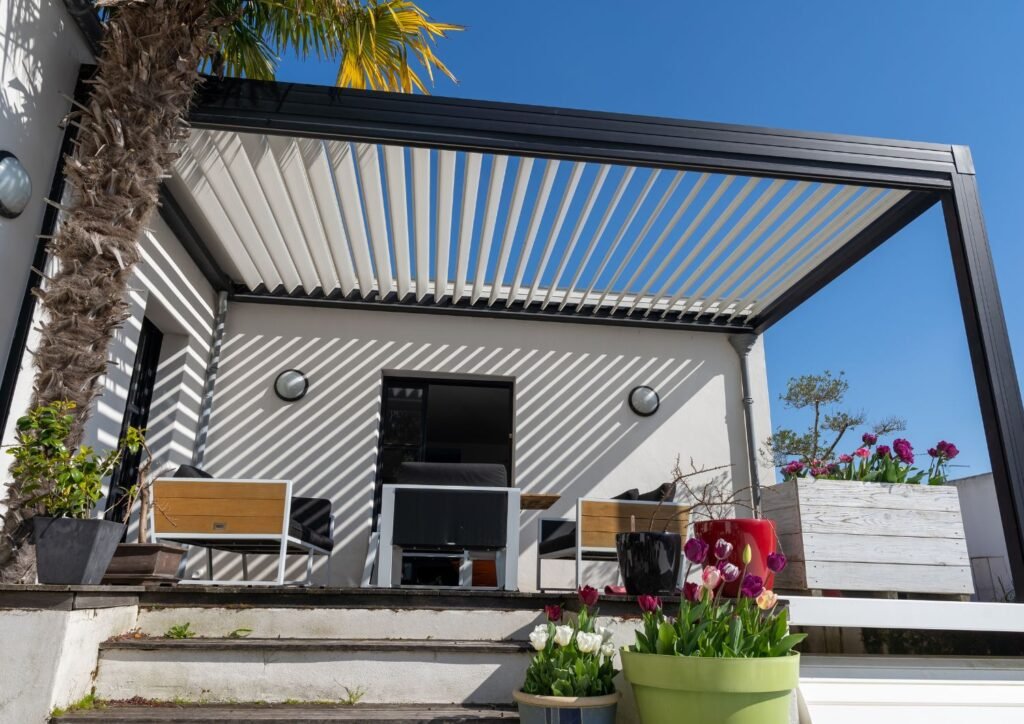
Personal Touches: Making the Garden Feel Like Home
Transforming an outdoor space into a true haven for seniors involves more than practical considerations—it requires thoughtful personalization that creates an emotional connection to the environment. These personal touches can transform a functional garden into a cherished sanctuary that reflects individual preferences and supports emotional well-being.
Accessories for Additional Comfort
High-quality outdoor cushions do more than provide physical comfort—they add warmth and personality to outdoor spaces:
- Ergonomic support: Look for cushions with a minimum of 2-3 inches of supportive foam and designs that provide lumbar support.
- Weather-resistant fabrics: Choose materials specifically engineered for outdoor use, such as solution-dyed acrylics that resist fading and mildew.
- Personalized colors and patterns: Select designs that reflect personal preferences and complement the overall garden aesthetic.
- Seasonal options: Consider having different cushion sets for various seasons to refresh the space and provide appropriate comfort year-round.
Cozy Throws and Blankets
For cooler evenings or seasonal transitions:
- Quick-dry materials: Look for outdoor-specific throws made from quick-drying synthetic fibers.
- Storage solution: Provide a weatherproof container to store throws when not in use, protecting them from moisture and extending their lifespan.
- Weighted options: For seniors who find comfort in gentle pressure, weatherproof weighted throws can provide soothing sensory input.
Therapeutic Heating Elements
To extend outdoor enjoyment through cooler seasons:
- Heated seat pads: Battery-operated or rechargeable options provide gentle, soothing warmth for muscles and joints.
- Safety features: Prioritize products with automatic shut-off features and temperature regulation to prevent overheating.
- Accessibility: Choose models with simple, intuitive controls that are easy to operate even with limited dexterity.
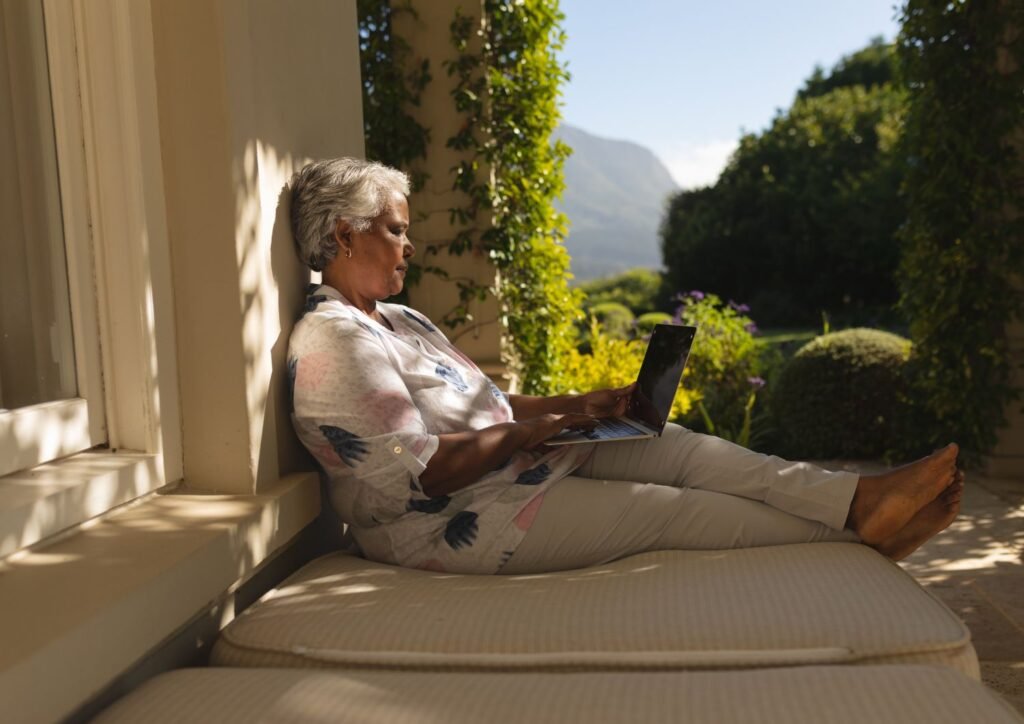
Creating Personal Connection Through Design
The most inviting gardens reflect the personalities and histories of those who use them:
Memory Gardens
Incorporating elements that evoke meaningful memories creates powerful emotional connections:
- Heritage plants: Include varieties that have personal significance, such as flowers from a childhood garden or native plants from a hometown region.
- Family heirlooms: Repurpose meaningful objects as garden art or planters—old wagons, antique milk cans, or ceramic pieces with sentimental value.
- Tribute spaces: Dedicate areas to honor loved ones or celebrate family traditions through plantings or decorative elements.
Sensory Elements
Engaging multiple senses creates a richer garden experience:
- Fragrant plants: Position aromatic herbs like lavender, rosemary, and mint near seating areas where their scents can be appreciated.
- Wind chimes: Select tones that are pleasing rather than jarring—deeper tones tend to be more soothing for sensitive ears.
- Textural contrast: Incorporate plants with interesting textures within reach of seating areas, encouraging tactile exploration.
Personal Interest Zones
Tailoring areas to specific interests increases engagement and enjoyment:
- Birdwatching stations: Position seating with good sightlines to bird feeders and baths.
- Hobby spaces: Create small areas dedicated to container gardening, reading, or other favorite activities.
- Art display: Incorporate weather-resistant display areas for rotating outdoor art pieces or family photographs protected in weather-resistant frames.
According to environmental psychology research published in the Journal of Environmental Psychology (2023), seniors whose outdoor spaces incorporate personalized elements report 42% higher emotional attachment to their homes and 37% greater satisfaction with their living environments compared to those with generic outdoor spaces.
Maintenance Tips: Keeping Seating and Shade in Top Condition
Proper maintenance ensures that seating and shade elements remain safe, functional, and enjoyable for years to come. A proactive approach to care not only extends the life of outdoor investments but also ensures continuous accessibility and comfort for seniors.
Material-Specific Cleaning Guidelines
Different materials require specific maintenance approaches to preserve their appearance and structural integrity:
Metal Seating (Aluminum, Wrought Iron)
- Regular cleaning: Wipe down with mild soap and water every 1-2 weeks during peak usage seasons.
- Rust prevention: For wrought iron, inspect for rust spots quarterly and treat immediately with rust converter followed by touch-up paint.
- Joint inspection: Tighten any loose screws or bolts at the beginning of each season and check monthly during regular use.
- Protective measures: Consider covering during extended periods of non-use or extreme weather conditions.
Wood and Polywood Maintenance
- Wood seating: Apply a new coat of weather-resistant sealer annually (ideally in spring) to prevent moisture damage.
- Polywood care: Clean with mild soap and water as needed; for stubborn stains, a soft brush with diluted vinegar solution (1:3 ratio with water) works effectively.
- Inspection routine: Check for splinters or rough spots monthly, sanding them smooth to prevent injury.
- Structural assessment: Annually inspect for signs of rot, especially at joints and ground contact points.
Fabric and Cushion Care
- Regular cleaning: Remove and clean cushion covers according to manufacturer instructions at least twice per season.
- Mildew prevention: Ensure cushions can dry completely after rain; store in dry conditions when not in use for extended periods.
- Spot treatment: Address stains promptly with appropriate cleaners designed for outdoor fabrics.
- Replacement schedule: Plan to replace outdoor cushions every 3-5 years, depending on quality and exposure conditions.
Shade Structure Maintenance
Natural Shade (Trees and Plants)
- Pruning schedule: Establish a regular pruning routine—annually for most trees, with seasonal touch-ups as needed.
- Professional assessment: Have large shade trees evaluated by a certified arborist every 2-3 years to identify potential hazards.
- Root management: Monitor for surface roots that might create tripping hazards near seating areas.
- Disease monitoring: Learn to recognize signs of common diseases affecting your shade plants and address promptly to prevent spread.
Architectural Shade Structures
- Framework inspection: Check all supporting elements and connection points at least twice yearly (spring and fall).
- Canopy care: Clean fabric canopies according to manufacturer specifications at least once per season.
- Winter preparation: In regions with snow, either remove fabric components or ensure the structure can support anticipated snow loads.
- Moving parts maintenance: For retractable systems, lubricate moving components according to manufacturer guidelines to ensure smooth operation.
Seasonal Maintenance Schedule
A structured approach to maintenance ensures nothing is overlooked:
Spring Preparation (March-April)
- Deep clean all seating and shade structures
- Apply protective treatments to wood surfaces
- Inspect for winter damage and make necessary repairs
- Test all mechanical components of adjustable shade systems
Summer Maintenance (May-August)
- Perform weekly cleaning of high-use areas
- Check and tighten hardware monthly
- Trim overhanging branches before summer storms
- Monitor and treat for pests that might damage wood components
Fall Readiness (September-October)
- Clean and store cushions if not used during winter
- Clear fallen leaves from seating areas and shade structures
- Prepare permanent structures for winter conditions
- Apply protective covers where appropriate
Winter Monitoring (November-February)
- Remove snow accumulation from permanent structures
- Periodically check for damage after severe weather events
- Address any repairs during milder winter days
- Plan for spring replacements or upgrades
By implementing a structured maintenance routine, you can significantly extend the life of outdoor investments while ensuring they remain safe and enjoyable for seniors year after year.
Wrapping It Up
Designing the perfect outdoor space with appropriate seating and shade for seniors is a journey worth taking. It’s about creating more than just a garden—it’s about crafting a sanctuary that nurtures well-being, encourages activity, and provides a peaceful retreat for relaxation and reflection.
Throughout this guide, we’ve explored the multifaceted aspects of creating senior-friendly outdoor spaces—from understanding unique needs and health benefits to selecting the right materials and adding personal touches. By thoughtfully implementing these guidelines, you can transform any outdoor area into a haven that supports physical comfort, emotional connection, and continued engagement with the natural world.
Remember that the most successful garden spaces evolve over time, adapting to changing needs and preferences. The perfect seating and shade solution is one that grows with you or your loved ones, continuing to provide comfort, safety, and joy through different seasons of life.
What aspects of your garden space are you most excited to enhance with these guidelines? Do you already have favorite seating spots that could benefit from improved shade options? We’d love to hear about your outdoor transformation plans in the comments below!
Frequently Asked Questions
- What materials are best for senior-friendly garden seating?
- Aluminum is excellent for its lightweight nature (typically 5-8 pounds per chair), making it easy to move while remaining durable and weather-resistant. Look for powder-coated finishes that resist chipping.
- Polywood offers the appearance of natural wood without maintenance concerns, resisting fading, splintering, and cracking. It’s heavier than aluminum but extremely stable.
- Teak and other hardwoods provide natural beauty and temperature regulation, staying cooler than metal in summer heat. Choose pieces with smooth, rounded edges for safety. Whatever material you select, always add high-quality cushions with weather-resistant fabrics for optimal comfort.
- How often should I inspect garden seating and shade structures?
- Conduct visual inspections monthly during regular use seasons, checking for loose parts, wear points, or damage. Perform more thorough structural inspections quarterly, including tightening hardware and examining joints.
- After extreme weather events (heavy storms, high winds, unusual temperature fluctuations), conduct immediate checks for damage. Schedule professional inspections of large shade trees annually and significant architectural structures (pergolas, gazebos) every 2-3 years.
- Can plants offer sufficient shade for seniors?
- While plants can provide excellent natural shade, most gardens benefit from a combined approach. Large deciduous trees can block 60-90% of solar radiation while allowing winter sun, but take years to mature.
- Fast-growing vines on structures like pergolas can provide interim shade while trees mature, creating a cooling effect within 1-2 seasons. For comprehensive protection, complement natural shade with architectural elements that provide immediate, controllable coverage, especially in areas where seniors spend extended periods.
- Consider seasonal variations—a perfectly shaded summer spot might be too cool in spring or fall without adjustable options.
- Are heated seat pads safe for seniors?
- Yes, when chosen and used properly. Look for models specifically designed for outdoor use with:
- Automatic shut-off features that prevent overheating
- Low-voltage systems that minimize electrical hazards
- Waterproof or water-resistant coverings
- UL or ETL safety certification
- Follow manufacturer guidelines for usage duration and temperature settings. Consider battery-operated options to eliminate tripping hazards from cords. Store indoors when not in use to extend product lifespan and maintain safety features.
- Yes, when chosen and used properly. Look for models specifically designed for outdoor use with:
- What’s the advantage of using a pergola or gazebo for shade?
- Pergolas and gazebos provide consistent, reliable shade regardless of seasonal plant changes. These structures create defined outdoor “rooms” that offer a sense of security and enclosure while remaining open to breezes and views.
- Modern versions offer adjustable features like retractable canopies that can be modified based on sun position and temperature. They create opportunities for lighting integration, extending outdoor enjoyment into evening hours. These structures serve as support for climbing plants, combining architectural stability with natural beauty.
- How can I add personal touches to enhance a senior’s garden experience?
- Incorporate elements that reflect personal history, such as plants that have significance from different life stages or regions. Add comfortable accessories like weather-resistant pillows in favorite colors or patterns.
- Include sensory elements that trigger positive memories—wind chimes similar to ones from childhood, fragrant plants that recall favorite places. Create spaces for favorite activities, whether birdwatching, reading, or small-scale gardening. Display weather-protected photographs or artwork that brings joy and connection to the outdoor space.
References
- American Academy of Dermatology. (2023). Sun Protection.
- Centers for Disease Control and Prevention. (2024). Older Adult Falls Data | Older Adult Fall Prevention | CDC
- U.S. Forest Service. (2023). The Power of Urban Trees.

